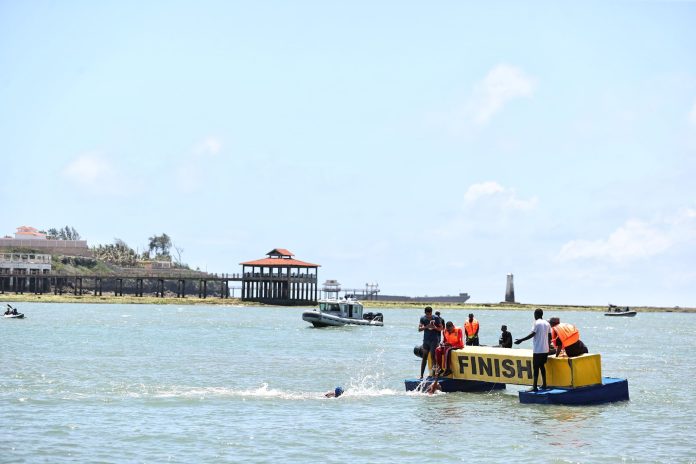A search operation is underway along Mombasa’s Tudor Creek after a boat capsized during the East African Ocean Festival on Friday (9th October 2025), leaving three Kenyan citizens missing and raising questions about the safety standards of regional maritime events. The incident occurred as the Kijiweni Beach Management Unit (BMU) team competed in the dragon boat race, one of the festival’s headline attractions meant to promote ocean sports and awareness around the blue economy.
According to officials, 22 participants were aboard the vessel MV Dragon when it overturned near the finish line at around 5:30PM that fateful day. Nineteen people were rescued and one is still in critical condition. The Kenya Navy, Coast Guard Service, and county disaster teams are leading the ongoing search for the remaining three. The East African Ocean Festival organizing committee confirmed the accident in a statement and announced the suspension of all remaining events to prioritize rescue efforts.
The festival, now in its second edition, was intended to celebrate the region’s maritime culture and promote coastal tourism through sport and environmental education. But what was planned as a showcase of ocean stewardship quickly turned into a test of safety coordination and emergency response capacity. The rescue operation drew in multiple agencies, including the Mombasa Fire and Rescue Services and volunteer divers, who worked through the night under challenging tidal conditions.
Mombasa County Lands Executive Mohamed “Amadoh” Hussein, who is overseeing the response, confirmed that coordination between agencies had been strengthened following early rescue difficulties. “We have enlisted full support from the Kenya Coast Guard and Navy. The search will continue until everyone is accounted for,” he said. Local reports indicate that at least one survivor was hospitalized and several others were treated for trauma.
Read also: Senegal’s $900 million ‘Pink Lake’ housing project sparks local opposition over environmental risks
Eyewitness accounts suggest the incident occurred during the second lap of the race as the team maneuvered near the last buoy. Survivors said strong currents and a sudden imbalance caused the boat to tip. Some participants struggled to stay afloat, with a few clinging to the overturned hull until rescuers arrived. “I saw people trying to hold onto one another to stay up. It was chaotic,” said one participant. “Rescue boats came as fast as they could, but it felt like forever.”
Safety lapses have since come under scrutiny. Several witnesses claimed not all racers were equipped with life jackets during the competition, despite using them in training earlier in the week. “Only a few teams had full safety gear,” one participant said. “Some were told there weren’t enough life jackets for everyone.” These claims have fueled concern about compliance with basic maritime event regulations, which require certified safety equipment, trained marshals, and pre-race safety audits by the Kenya Maritime Authority.
Read also: Lagos hosts Africa’s first Electric Powerboat Race, steering a shift in the continent’s Blue Economy
The East African Ocean Festival was designed to advance the county’s blue economy strategy, promoting sustainable livelihoods linked to marine resources, eco-tourism, and cultural heritage. The event had drawn teams from Kenya and neighboring countries, combining sport with coastal conservation awareness. It was expected to draw thousands of spectators and create economic opportunities for local vendors and water-sport operators. That optimism has now been replaced by caution as investigators assess what went wrong.
Emergency response teams faced unexpected challenges as tensions flared at the site. Mombasa County Disaster Coordinator Ibrahim Basafar said his crew was attacked by frustrated spectators as they worked to stabilize rescued victims. “We were providing first aid when some youths began throwing stones,” he said. “Our ambulance was damaged while transporting one of the critical cases. It demoralized the team at a time we were trying to save lives.”
The county has launched an internal review to establish whether event organizers met all required safety conditions. Officials confirmed that organizers will be asked to provide documentation on safety compliance, including participant registration, emergency preparedness, and watercraft inspection reports. Maritime safety experts note that as interest in marine sports grows across Africa’s coastal cities, there is a pressing need for standardized event protocols to minimize risks on open waters.
The tragedy has stirred reflection among coastal stakeholders who see ocean-based events as vital to promoting sustainable blue economies. Kenya’s coastal counties, Mombasa, Kilifi, and Kwale, are key to the country’s strategy of generating employment through ocean tourism, marine transport, and fisheries. The incident at Tudor Creek underscores the balance between expanding public engagement in ocean activities and ensuring that safety infrastructure keeps pace with growing participation.
As of Sunday afternoon, divers from the Kenya Navy continued operations across the creek as families of the missing gathered at the shore. The search area spans several kilometers, complicated by strong currents and limited underwater visibility. Officials have not confirmed whether future festival activities will resume, but organizers have pledged full cooperation with authorities and support for the affected families.
Read also: Kenya, Tanzania, and Djibouti Ports compete for trade supremacy amid rising regional investments
The East African Ocean Festival was established to reconnect communities with the sea, through sport, culture, and environmental awareness. This year’s event has instead become a reminder of the human cost when preparation falls short. The conversations that follow will likely influence how future coastal events are managed, not just in Mombasa, but across Africa’s expanding maritime frontiers.







